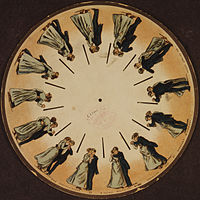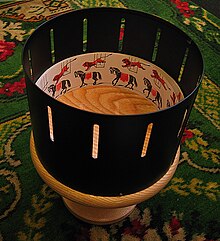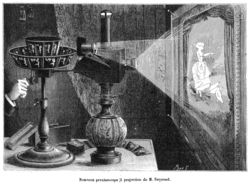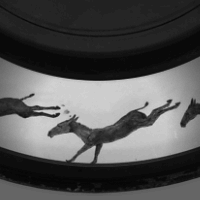Stop Motion Animation Reasearch
Stop Motion Animation in TV
Dominating children's TV stop motion programming for three decades in America was Art Clokey's Gumby series, which spawned a feature film, Gumby I in 1995, using both freeform and character clay animation. Clokey started his adventures in clay with a 1953 freeform clay short film called Gumbasia which shortly thereafter propelled him into his more structured Gumby TV series.
Rankin/Bass is a very famous stop-motion company. Since the 1960s it has been making many stop-motion Christmas specials such as Rudolph the Red-Nosed Reindeer, The Year Without a Santa Claus, Santa Claus is Coming to Town, and many others.
In November 1959 the first episode of Sandmännchen was shown on East German television, a children's show that had Cold War propaganda as its primary function. New episodes are still being produced in Germany, making it one of the longest running animated series in the world. However, the show's purpose today has changed to pure entertainment.
In the 1960s, the French animator Serge Danot created the well-known The Magic Roundabout which played for many years on the BBC.
The British artists Brian Cosgrove and Mark Hall (Cosgrove Hall Films) produced a full length film The Wind in the Willows and later a multi-season TV series The Wind in the Willows based on Kenneth Grahame's classic children's book of the same title. They also produced a documentary of their production techniques, Making Frog and Toad.
All information is gathered from here.
Friday 28 January 2011
Thursday 27 January 2011
Group Activity
Group Activity
For my stop motion animation work i was required to work in a group to discuss ideas and what we are planning to do in our attempt of making a stop motion animated ident for a tv channel.
Jack | Jordan | Dan | Gary | |
Stick to subject | Y | Y | Y | Y |
Sitting appropriately | Y | Y | Y | Y |
Using pauses | Y | Y | Y | Y |
Correct voice tone | Y | Y | Y | Y |
0937 – Discussing ideas
0939 discuss character ideas
0941 discuss resources
0945 research idents
0949 summarise research
0952 channel research
0954 cbeebies ident is chosen idea
0956 colours used etc
0958 Meeting closed
Jack – research children's idents
Jordan – research cbeebies
Gary – research clay stop motion
Dan – research stop motion animation techniques
Thursday 20 January 2011
Music Powerpoint
Above is mine and Gary's Powerpoint which compares a popular band, in this case The Killers, with a not so popular band, Walk Off The Earth. Also, this displays differently on Google documents, the PowerPoint version works fine and there are many interactive elements to this such as hyperlinks and embedded video which will not display on the online version.
Wednesday 19 January 2011
Response to Peer-Assessment
On my blog there has been a few comments on my 'The 12 basic principles of animation'.
I have been asked to respond to these comments by answering the following four questions.
1. How will you meet these targets?
To meet the targets i have been set i shall add more illustrations to show what i am explaining in each principle and i shall go into more detail on each principle too.
2. What have you enjoyed about this learning episode?
Although I'm not entirely sure what is meant by a 'learning episode' what i did enjoy about creating that post and receiving comments on it was the actual research that was done for it, i found it interesting learning how complicated animation could truly be.
3. What have you found challenging about this learning episode?
I think the most challenging part of this learning episode was the technical difficulties that came across whilst doing the post, sometimes the web pages would take ages to load and sometimes flash wasn't working so it was hard for me to find examples. Another challenging part was making the information as clear as i possibly could as in it's pure form it was rather complicated.
4. What would help you improve in these aspects in the future?
To improve in these aspects in the future i think that better equipment would help me improve as well as more resources as i couldn't find that many places which had information about the 12 principles. I think the place that had the most information was Wikipedia which isn't very reliable as it can be edited by anyone.
I have been asked to respond to these comments by answering the following four questions.
1. How will you meet these targets?
To meet the targets i have been set i shall add more illustrations to show what i am explaining in each principle and i shall go into more detail on each principle too.
2. What have you enjoyed about this learning episode?
Although I'm not entirely sure what is meant by a 'learning episode' what i did enjoy about creating that post and receiving comments on it was the actual research that was done for it, i found it interesting learning how complicated animation could truly be.
3. What have you found challenging about this learning episode?
I think the most challenging part of this learning episode was the technical difficulties that came across whilst doing the post, sometimes the web pages would take ages to load and sometimes flash wasn't working so it was hard for me to find examples. Another challenging part was making the information as clear as i possibly could as in it's pure form it was rather complicated.
4. What would help you improve in these aspects in the future?
To improve in these aspects in the future i think that better equipment would help me improve as well as more resources as i couldn't find that many places which had information about the 12 principles. I think the place that had the most information was Wikipedia which isn't very reliable as it can be edited by anyone.
Tuesday 18 January 2011
Development

 Joseph Antoine Ferdinand Plateau was a Belgian physicist. He was the first person to demonstrate the illusion of a moving image. To do this he used counter rotating disks with repeating drawn images in small increments of motion on one and regularly spaced slits in the other. He called this device of 1832 the phenakistoscope.
Joseph Antoine Ferdinand Plateau was a Belgian physicist. He was the first person to demonstrate the illusion of a moving image. To do this he used counter rotating disks with repeating drawn images in small increments of motion on one and regularly spaced slits in the other. He called this device of 1832 the phenakistoscope. William Horner
 A zoetrope is a device that produces an illusion of action from a rapid succession of pictures. The term zoetrope is from the Greek words "zoe", "life" and tropos, "turn". It may be taken to mean "wheel of life".It consists of a cylinder with slits cut vertically in the sides. Beneath the slits on the inner surface of the cylinder is a band which has either individual frames from a video/film or images from a set of sequenced drawings or photographs. As the cylinder spins the user looks through the slits at the pictures on the opposite side of the cylinder's interior. The scanning of the slits keeps the pictures from simply blurring together so that the user sees a rapid succession of images producing the illusion of motion, the equivalent of a motion picture. Cylindrical zoetropes have the property of causing the images to appear thinner than their actual sizes when viewed in motion hrough the slits.
A zoetrope is a device that produces an illusion of action from a rapid succession of pictures. The term zoetrope is from the Greek words "zoe", "life" and tropos, "turn". It may be taken to mean "wheel of life".It consists of a cylinder with slits cut vertically in the sides. Beneath the slits on the inner surface of the cylinder is a band which has either individual frames from a video/film or images from a set of sequenced drawings or photographs. As the cylinder spins the user looks through the slits at the pictures on the opposite side of the cylinder's interior. The scanning of the slits keeps the pictures from simply blurring together so that the user sees a rapid succession of images producing the illusion of motion, the equivalent of a motion picture. Cylindrical zoetropes have the property of causing the images to appear thinner than their actual sizes when viewed in motion hrough the slits.Emile Reynaud
 Émile Reynaud was a French science teacher, responsible for the first projected animated cartoon films. Reynaud created the Praxinoscope in 1877. The praxinoscope was an animation device, the successor to the zoetrope. Like the zoetrope, it used a strip of pictures placed around the inner surface of a spinning cylinder. The praxinoscope improved on the zoetrope by replacing its narrow viewing slits with an inner circle of mirrors, placed so that the reflections of the pictures appeared more or less stationary in position as the wheel turned. Someone looking in the mirrors would therefore see a rapid succession of images producing the illusion of motion, with a brighter and less distorted picture than the zoetrope offered.
Émile Reynaud was a French science teacher, responsible for the first projected animated cartoon films. Reynaud created the Praxinoscope in 1877. The praxinoscope was an animation device, the successor to the zoetrope. Like the zoetrope, it used a strip of pictures placed around the inner surface of a spinning cylinder. The praxinoscope improved on the zoetrope by replacing its narrow viewing slits with an inner circle of mirrors, placed so that the reflections of the pictures appeared more or less stationary in position as the wheel turned. Someone looking in the mirrors would therefore see a rapid succession of images producing the illusion of motion, with a brighter and less distorted picture than the zoetrope offered. Eadwward Muybridge was an English photographer who spent much of his life in the United States. He is known for his pioneering work on animal locomotion which used multiple cameras to capture motion, and his zoopraxiscope. The zoopraxiscope projected images from rotating glass disks in rapid succession to give the impression of motion. The stop-motion images were initially painted onto the glass, as silhouettes. A second series of discs, made in 1892-94, used outline drawings printed onto the discs photographically, then colored by hand. Some of the animated images are very complex, featuring multiple combinations of sequences of animal and human movement. The device appears to have been one of the primary inspirations for Thomas Edison and William Kennedy Dickson's Kinetoscope.
Eadwward Muybridge was an English photographer who spent much of his life in the United States. He is known for his pioneering work on animal locomotion which used multiple cameras to capture motion, and his zoopraxiscope. The zoopraxiscope projected images from rotating glass disks in rapid succession to give the impression of motion. The stop-motion images were initially painted onto the glass, as silhouettes. A second series of discs, made in 1892-94, used outline drawings printed onto the discs photographically, then colored by hand. Some of the animated images are very complex, featuring multiple combinations of sequences of animal and human movement. The device appears to have been one of the primary inspirations for Thomas Edison and William Kennedy Dickson's Kinetoscope. Thomas Edison was an American inventor who developed many devices that greatly influenced life around the world, including the phonograph, the motion picture camera, and a long-lasting, practical electric light bulb. He also invented the Kinetoscope, the Kinetoscope is an early motion picture exhibition device. The Kinetoscope introduced the basic approach that would become the standard for all cinematic projection before the advent of video: it creates the illusion of movement by conveying a strip of perforated film bearing sequential images over a light source with a high-speed shutter. First described in conceptual terms by U.S. inventor Thomas Edison, it was largely developed by his employee William Dickson. Dickson and his team at the Edison lab also devised the Kinetograph, an innovative motion picture camera with rapid intermittent, or stop-and-go, film movement, to photograph movies for in-house experiments and, eventually, commercial Kinetoscope presentations.
Thomas Edison was an American inventor who developed many devices that greatly influenced life around the world, including the phonograph, the motion picture camera, and a long-lasting, practical electric light bulb. He also invented the Kinetoscope, the Kinetoscope is an early motion picture exhibition device. The Kinetoscope introduced the basic approach that would become the standard for all cinematic projection before the advent of video: it creates the illusion of movement by conveying a strip of perforated film bearing sequential images over a light source with a high-speed shutter. First described in conceptual terms by U.S. inventor Thomas Edison, it was largely developed by his employee William Dickson. Dickson and his team at the Edison lab also devised the Kinetograph, an innovative motion picture camera with rapid intermittent, or stop-and-go, film movement, to photograph movies for in-house experiments and, eventually, commercial Kinetoscope presentations.The Lumiere Brothers
 The Lumière brothers created moving pictures. They patented a number of significant processes leading up to their film camera . The cinématographe itself was patented on 13 February 1895 and the first footage ever to be recorded using it was recorded on March 19, 1895. This first film shows workers leaving the Lumière factory. Although the Lumière brothers were not the first inventors to develop techniques to create motion pictures, they are often credited as one of the first inventors of Cinema as a mass medium, and are among the first who understood how to use it. By comparison, it is argued that Thomas Edison may have meant his invention as entertainment for rich people, not as a movie to be seen in public.
The Lumière brothers created moving pictures. They patented a number of significant processes leading up to their film camera . The cinématographe itself was patented on 13 February 1895 and the first footage ever to be recorded using it was recorded on March 19, 1895. This first film shows workers leaving the Lumière factory. Although the Lumière brothers were not the first inventors to develop techniques to create motion pictures, they are often credited as one of the first inventors of Cinema as a mass medium, and are among the first who understood how to use it. By comparison, it is argued that Thomas Edison may have meant his invention as entertainment for rich people, not as a movie to be seen in public.George Pal
George Pal was a Hungarian-born American animator and film producer, principally associated with the science fiction genre. George created many productions for Paramount including Puppetoons and switched to live action film making producing The Great Rupert. George passed away at the age of 72, he has got a star on the Hollywood walk of fame and in 1980 the Academy of Motion Pitcure Arts and Sciences founded the "George Pal Lecture on Fantasy in FIlm" in his memory.
Friday 14 January 2011
Music Powerpoint
Above is mine and Gary's powerpoint comparing a mainstream band (The Killers) with a not so pmainstream band (Walk Off the Earth {WOTE}). Also, please note that this displays differently on Google documents, rest assured the powerpoint version works fine, also there are many interactive elements to this such as hyperlinks and embedded video which will not display on the online version.
Friday 7 January 2011
Editing for Teenagers
Editing for Teenagers from Gary & Dan on Vimeo.
The Killers Powerpoint
This is a group powerpoint about the band 'The Killers'. The powerpoint is not yet finished as we have still got to add information about the group 'Walk Off The Earth'. The group who created this consised of me, Gary and Gavin.
Thursday 6 January 2011
The 12 basic principles of animation
Squash and Stretch is the most important principle of animation. It gives drawn objects a sense of weight and flexability, it can be applied to many things from a bouncy ball to a human face. If it is done to an exagurated degre it can have a comical effect. In realistic animation however the key part of this is that an objects volume does not change.
< This picture uses Squash and Stretch on the sails eyes to make them droopy and make the snail look saddened
2. Anticipation
Anticipation is used to make the audience prepared for an action and to make the action appear more realistic. An example of this would be if someone is going to jump they have to bend their knees first. You can also use this in a comical way if you make the audience anticipate something then make something different happen.< It is used here to make the audience anticipate the snail getting squished by the falling object.
Staging is used to make the audience know where they are supposed to be looking. If done well you can distract the audience from one thing to make it more of a surprise or you can switch the audiences attention form one thing to another at any time you wish.
< Staging is used here to make you look at the front half of the snail, sometimes staging can be something like a simple closte up then if you zoom out they will still be looking at the thing that had the close up.
5. Follow through and overlapping action
 The movement of the human body, and most other objects, needs time to accelerate and slow down. For this reason, animation looks more realistic if it has more frames near the beginning and end of a movement, and fewer in the middle. This principle goes for characters moving between two extreme poses, such as sitting down and standing up.
The movement of the human body, and most other objects, needs time to accelerate and slow down. For this reason, animation looks more realistic if it has more frames near the beginning and end of a movement, and fewer in the middle. This principle goes for characters moving between two extreme poses, such as sitting down and standing up. < Here is a short animation i created showing an example of slow in, the snail takes time to speed up.
7. Arcs
< Here is an exaple using an arc, this one shows the snails neck bending to face the audience.
8. Secondary action
Adding secondary actions to the main action gives a scene more life and can help support the main action. The important thing about secondary actions is that they emphasize instead of taking attention away from the main action. If it does take the attention from the main action then it is better to leave it out.
< The main action in this shot is the snail moving, the secondary action is the object falling above it.
9. Timing
9. Timing
Timing refers to the number of drawings or frames for a given action which translates to the speed of the action on film. Correct timing can make objects appear to abide the law of physics. It is also iportant in establishing a characters mood, emotion and reactions. It can also show aspects of a characters personality.
In the short animation above (in section 6. slow in and slow out) there is fast timing but it also makes the snail look like itis abiding the law of friction.
Exaggeration is an effect that can be used to a comic effect by exaggerating parts of a character or object. Exaggeration is not used as much in realistic animation compared to how much it is used in a more cartoony animation. If a scene contais a lot of exaggeration it is important to make sure that there is a balance of how exagerated things are. In this picture the exaggeration is on the head of the snail to show an exagerated expression (although in this picutre the expression isnt that clear.. it's supposted to be shock by the way)
11. Solid drawring
11. Solid drawring
The priciple of solid drawring is taking into account forms in three-dimensional space, giving them volume and weight. To do this you have to understand the basics of three-dimensional shapes, anatomy, weight, balance, light and shadow.
12. Appeal
Appeal in a cartoon character is what charisma is to an actor. A character who is appealing is not necessarily sympathetic, villains can also be appealing, the important thing is that the viewer feels the character has a sense of life in it and is interesting. There are many ways to make a character connect with the audience better, for likeable caracters a symmetrical or baby-like face tends to work.
Subscribe to:
Posts (Atom)